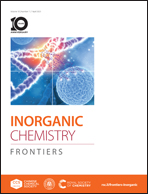Dual-cation doping precisely reducing the energy barrier of the rate-determining step for promoting oxygen-evolving activity†
Abstract
The energy barrier for the rate-determining step (RDS) is exceptionally critical for the catalytic oxygen evolution reaction (OER) efficiency of an electrocatalyst; however, facilely decreasing the energy barrier of RDS and realizing the precise manipulation of the reaction process remains challenging. Herein, through constructing a nanosheet assembled sunflower-like Co(OH)2 with Ir, Fe codoping, the electronic structure and binding strengths with oxygen-involved intermediates of Co active sites are considerably moderated. First-principles calculations and comprehensive characterizations suggest that Fe and Ir codoping significantly lowers the electrochemical reaction barrier and promotes the OER reaction kinetics by precisely accelerating the formation process of *O. Moreover, the nanosheet-assembled open architectures enable the catalyst with plentiful catalytically active sites and facilitate mass transport and electron transfer. As a result, the optimal electrocatalyst can exhibit outstanding oxygen-evolving activity with an ultralow overpotential of 254 mV at 10 mA cm−2. This study realizes the precise manipulation of the reaction energy barrier of OER via Ir, Fe dual doping, which will be a generic paradigm for designing advanced yet cost-effective electrocatalysts.



 Please wait while we load your content...
Please wait while we load your content...